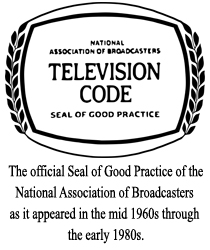 |
Why is that on Television? By Roger Crigger
Want to know why shows about producing and selling methamphetamine or a blood spatter pattern analyst who also leads a secret life as a serial killer or commercials advertising products of personal nature, lotteries, or hard liquor was not on television 30 years ago? Because 30 years ago there was a voluntary Code of Practices for Television Broadcasters that did not allow this type of programming or commercials to be on television. |
On December 6, 1951 a set of ethical standards was adopted by the National Association of Broadcasters (NAB) by which television stations should conduct themselves in the areas of programming and advertising? Compliance with the voluntary code was indicated by the "Seal of Good Practice" (see image to right), displayed during closing credits on most United States television programs from 1952 through the early 1980s. In 1983, it was ruled in that the Television Code violated the Sherman Anti-Trust Act and was responsible for keeping the cost of TV commercials artificially high and declared the code unlawful. Although the code was suspended in 1983, television still has some regulations about what can and cannot be said and seen on television but that varies between network and cable/satellite programming. In a nut shell what was this code you ask? Wikipedia says: "The code prohibited the use of profanity, the negative portrayal of family life, irreverence for God and religion, illicit sex, drunkenness and addiction, presentation of cruelty, detailed techniques of crime, the use of horror for its own sake, and the negative portrayal of law enforcement officials, among others. The code regulated how performers should dress and move to be |
 |
within the "bounds of decency". Further, news reporting was to be "factual, fair and without bias" and commentary and analysis should be "clearly defined as such". Broadcasters were to make time available for religious broadcasting and were discouraged from charging religious bodies for access. Most importantly, it limited the commercial minutes per hour". |
|
| CLICK TO CONTINUE |







